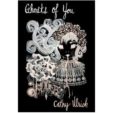In so many stories of women’s murders, both fictional and nonfictional, the emphasis is on the crime and killer, with the women portrayed as little more than victims. Often, we get little sense of who they were and how their loss affects their friends, loved ones, or the wider community. Cathy Ulrich’s arresting new story collection, Ghosts of You, turns this narrative frame on its head, resulting in fiction that is, by turns, haunting, thought-provoking, and deeply moving.
Each story is told from the point of view of a murdered girl or woman, and her control over the narrative is present from the very start of each story, with titles that begin with “Being”: “Being the Murdered Girl,” “Being the Murdered Wife,” “Being the Murdered Lover,” and so on. This sense of control continues with the first line of each story, which reads, “The thing about being the murdered _____ is you set the plot in motion.” From here, we’re launched into compelling tales of the “ghosts” the women have left behind, often including reactions to their murders.
One common real-world reaction is judgment or blame of murdered women, which Ulrich addresses–and implicitly critiques–in several of the stories. In “Being the Murdered Coed,” for example, the narrator observes, “The police won’t blame you for your own murder, not really, but they’ll think if you had maybe been carefuller.” In “Being the Murdered Girlfriend,” the narrator gets an afterlife window on the boyfriend who was responsible for her death, and on his mother, who can’t bring herself to believe that he’s to blame. The murdered girlfriend imagines that her friends will sympathize with the mother:
One of the most moving aspects of Ghosts of You is its exploration of loss–especially, how the murders of girls and women leave a void in the lives of their family members, long after the larger community has mostly forgotten the victims. In “Being the Murdered Indian,” Ulrich writes:
In stark contrast with her grief, the mother has discovered that “the feds” are indifferent to the loss of her daughter, telling her after her daughter goes missing that she’s probably run away. Later, it becomes clear that they’ve given up on the case. Still, the mother and others close to the victim remain haunted by her loss, in the face of indifference and the passage of time, captured poetically in the story’s final sentence:
One of the most powerful stories in the collection, to my mind, explores how murder can affect those who never knew the victim but are traumatized, or otherwise affected, by the crime. In “Being the Murdered Jogger,” the motorist who discovered the jogger’s body can’t stop thinking about her, and “will never be able to listen to the song he heard from [the jogger’s] headphones again.” And, understandably, he’s apprehensive when his wife, a former pole vaulter, goes out for a jog before sunrise.
Although the story doesn’t enter the wife’s point of view, the fact that she continues with her jogging in the wake of the murder makes a strong statement, one that many other women would agree with: we cannot and must not be stopped from going about our lives despite whatever threats may exist, and despite our fears and the fears of our loved ones.
Collectively, the stories make another strong statement: that whenever we read a news story or some other account of a woman’s murder, we should be mindful of everything that the story might be excluding or simplifying, and we should check any impulse to judge or blame.
Would My Pick be Your Pick?
If you're interested in ________, the answer may be "Yes":▪ Flash fiction
▪ Crime fiction
▪ Empathetic representations of murder victims and of those affected by their deaths


